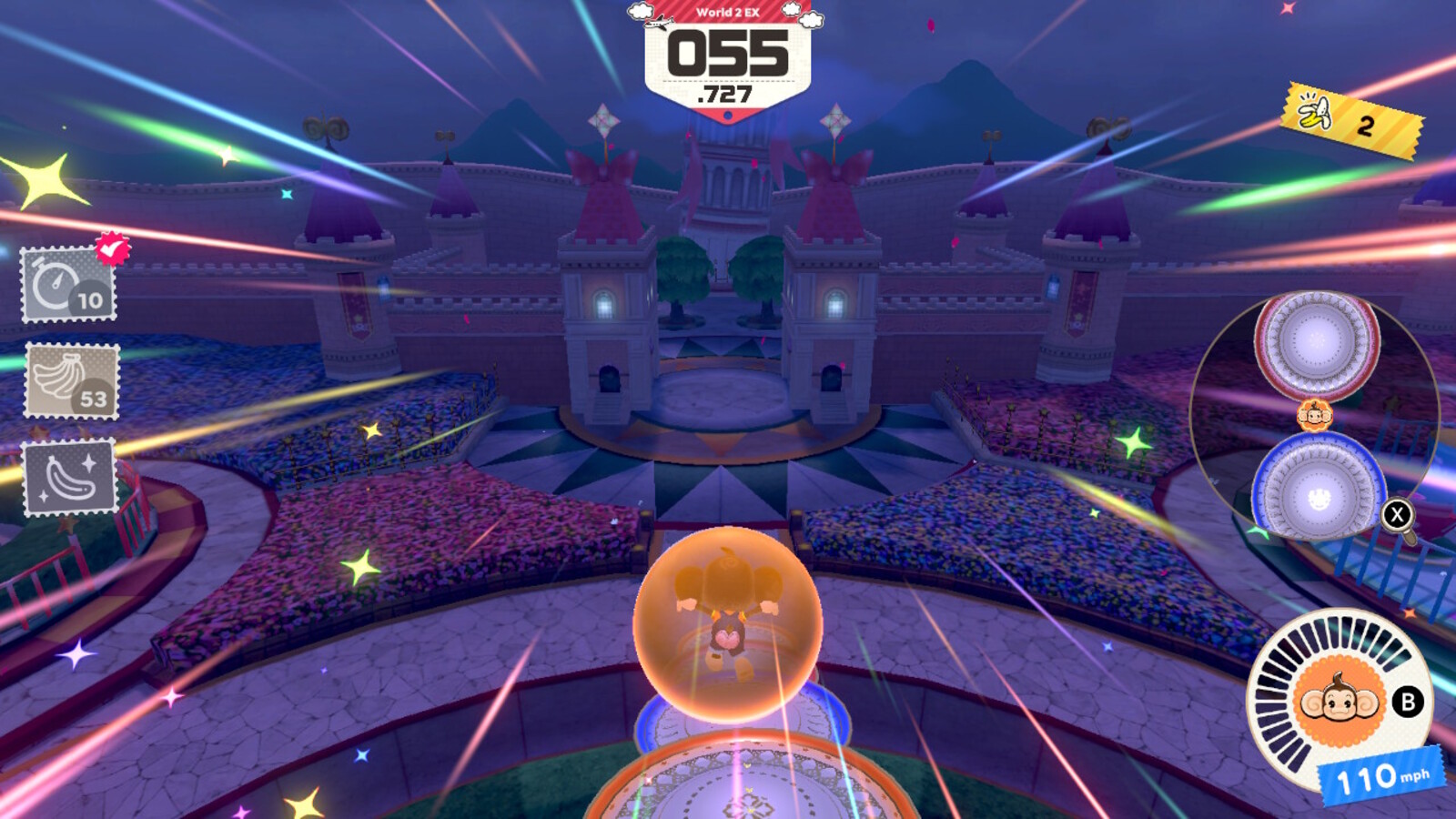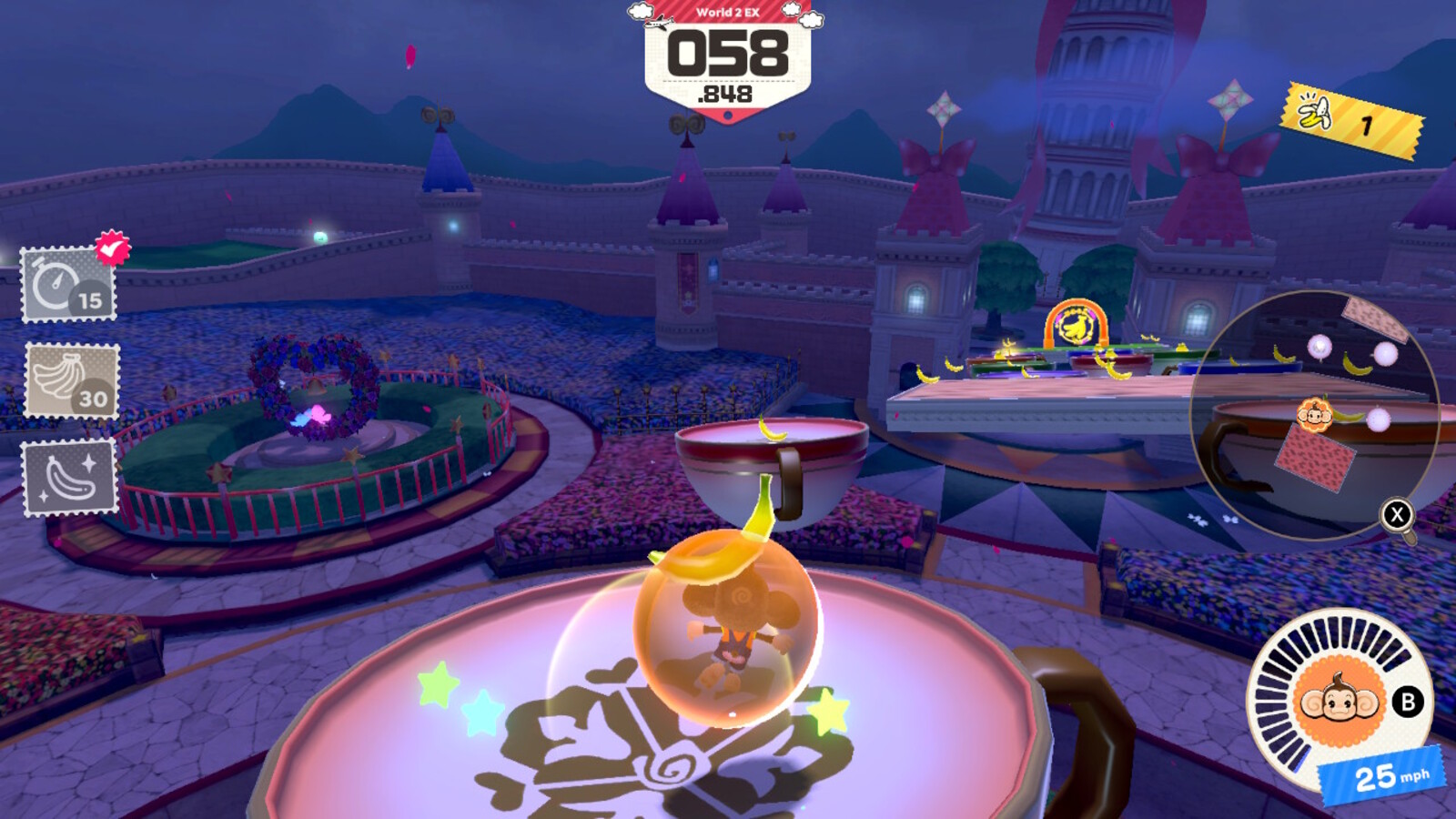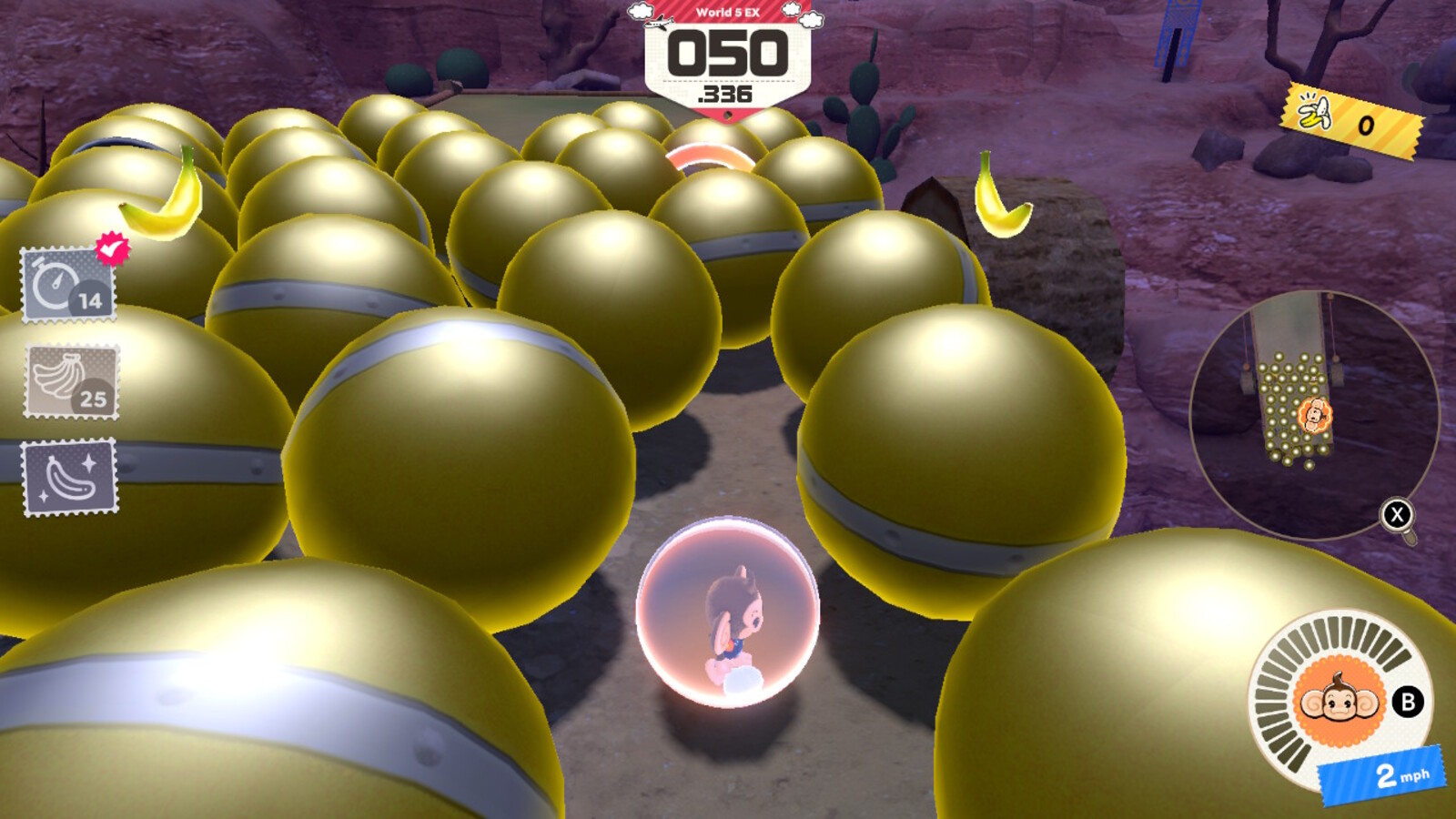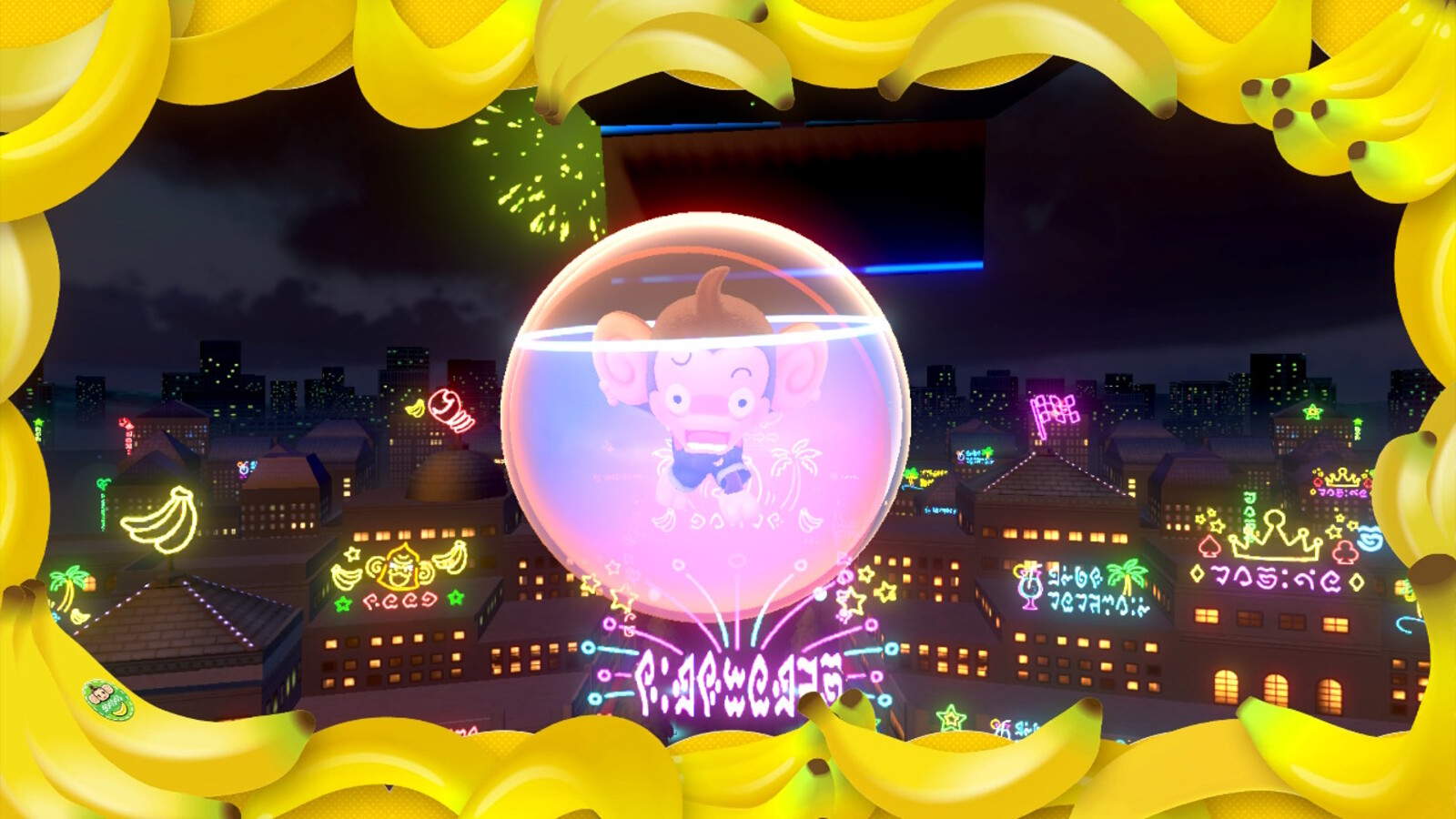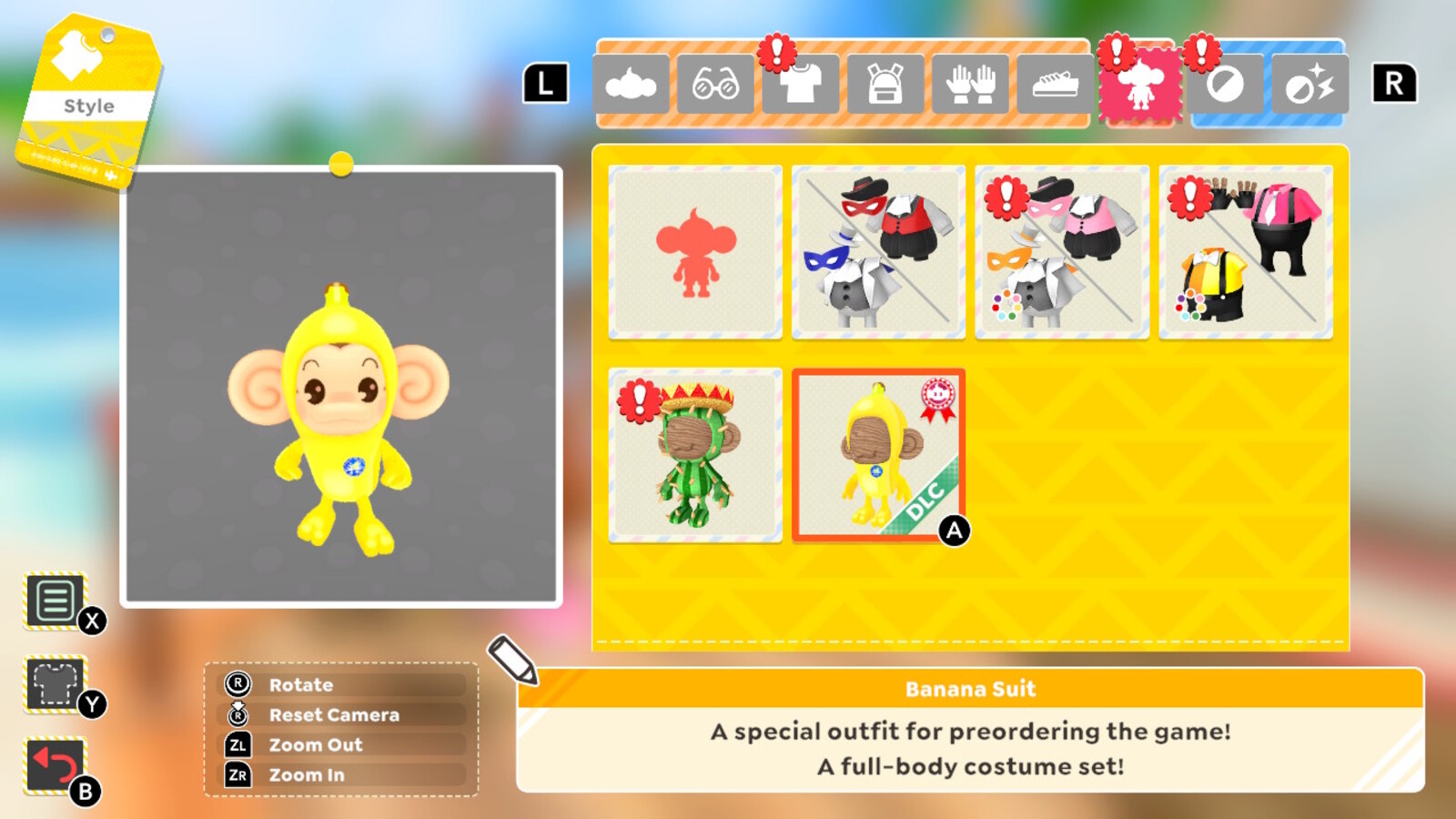
As the saying goes, you can’t teach an old monkey new tricks. Not because it’s physically impossible, but because it risks upsetting the carefully balanced appeal of trapping the monkey in a ball and rolling it around. The Super Monkey Ball series has historically struggled with how to expand its concept without damaging its fundamental idea. From varying flavors of motion controls. touch controls, and a jumping mechanic, past attempts have had merits and drawbacks in relatively equal measure.
Banana Rumble, the first legitimately new Monkey Ball game in over a decade, introduces a Spin Dash mechanic. This idea was almost certainly gleaned from Sonic the Hedgehog (he’s been hanging around the monkeys the past few remakes) and complements the Monkey Ball formula better than any previous attempt to expand the concept. Every aspect of Banana Rumble extends from the Spin Dash, which propels the series forward in an exciting direction.
For the unfamiliar, Super Monkey Ball Banana Rumble is a roll-playing game. As in you play as a monkey that rolls around in a ball navigating various obstacle courses. The appeal lies in mastering its unconventional approach to movement and controls. Rather than moving the (monkey) ball directly, you tilt the floor of the stage itself, creating a degree of separation and nuance to the controls to wrap your head around. To play Monkey Ball is to fully understand physics and its disastrous consequences. Few things are more fulfilling in life than successfully navigating Monkey Ball courses and eventually obtaining your PhD in Advanced Monkeynomics.
Little known fact: while aiming for my PhD I actually wrote my thesis on the physical impossibility of Monkey Ball monkeys collecting the bananas that they roll into. How are they grabbing them when they’re inside a ball? The bananas should just bounce away on contact. I didn’t have the answer, so the paper was mostly a bunch of space-filling nonsense like this sentence…alright, I’m done monkeying around.
The highlights of playing Monkey Ball generally revolve around tension. Carefully balancing your monkey across a narrow platform, adjusting your monkey in the air so that they land just right, and rolling off a surface at just the right speed and angle to massively skip giant sections of a level…these moments are what makes Monkey Ball great. A single wrong move can send you careening off of the stage. That risk makes the nuance of the controls shine. Monkey Ball rewards true mastery of the game mechanics and the level design with the ability to pull off impressive feats, and Banana Rumble is no different.
If anything, Banana Rumble places greater emphasis on tense, skillful play with the inclusion of the Spin Dash. This mechanic allows you to charge and release energy at virtually any time, giving your monkey access to sudden speed bursts. Speed-on-demand helps you do all sorts of things like quickly scale inclines, blast your monkey off of ramps to cross large distances, and quickly change directions despite your momentum.
Like the jump mechanic in prior Monkey Ball games, it’s the kind of tool that immediately feels overpowered given the nature of these games. So much of the depth of Monkey Ball comes from learning to manipulate the rolling physics to build up speed and do impressive tricks without needing something like a Spin Dash. To put it somewhat unkindly, then, rather than something that enhances the gameplay, it’s easy to see the Spin Dash as something that lets you skip what makes Monkey Ball fun.
The Spin Dash works because it maintains the risk and necessity of mastery that are essential to the core Monkey Ball gameplay. Spin Dashing requires the player to carefully consider how they use it from the moment they press down the button to activate it. By holding down a button, your monkey will charge up energy, and letting go at various levels of charge results in different degrees of boost. After using a spin dash, you need to wait for it to recharge before doing it again. Thanks to these details, charging not only brings in an element of timing, but also for a wide variety of utility. You can use a small charge to micromanage your movement or maintain speed, while reserving the full charge for more dramatic maneuvers like launching yourself from an incline to the other end of the stage.
It takes practice to fully take advantage of everything the Spin Dash brings to the table. If you’re aiming to speedrun the game, the micro adjustments that consistent boosting provides are vital yet easy to mess up. That’s not even getting into how easily going too fast can wrench away your control over the ball and send you barrelling towards your doom. Learning how to control a Monkey Ball game already comes with a built-in learning curve that lessens as you play, and I found myself going through it all over again while adjusting to the Spin Dash. In a way, that’s kind of the best case scenario for a game all about the fun of learning how to control it.
Speaking of control, the developers have made a point to say that Banana Rumble has “improved physics” relative to its predecessors. To translate what exactly that means, Monkey Ball purists have had some contentions with the prior remakes as there are some notable differences in the physics and how the monkeys handle. I can’t say Banana Rumble handles in a 1:1 manner compared to the classic Monkey Ball games, but it does feel different from the remakes and noticeably easier to control. The one thing that seems slightly suspect to me is the air control – it’s incredibly easy to over and undershoot where you land in this game in a way that took a lot of adjustment. Maybe that can be owed to the Spin-Dash induced speed boosts that typically send your monkey soaring. Ultimately, I don’t think different physics matter as much here compared to the remakes, as obviously this game was built from the ground up with its physics in mind rather than trying to retrofit it into past levels.
Banana Rumble features an Adventure Mode with 200 stages – 100 for the main story and 100 for the post-game. If we’re just talking about playing through the levels to survive and reach the end, I’d say that Banana Rumble generally sits on the easier end of the Monkey Ball spectrum despite the post-game levels ramping the difficulty level up to where you’d expect for this series (you know, hard). That said, I also didn’t find Banana Rumble’s levels to be easy in a boring way like some sequels have bordered on being. These levels typically suit the Spin Dash well by offering plenty of opportunities to take advantage of the speed boosts for advanced players while still requiring careful movement and mastery for those who choose to forgo it.
You can easily see the difficulty that comes with balancing a game like this – some levels, even late game stages, can be invalidated entirely by a careful Spin Dash near the start for a clear in less than 5 seconds. I don’t consider this a flaw in part because it’s similar to how you could clear some stages in prior games by simply memorizing how to fall off a ledge at the start, and in part because the game offers plenty of ways to mitigate the damage. Some levels simply aren’t set up to be abused in that way or are too complex to allow for it. However, even the simple or easily exploited levels retain some life to them if you’re willing to play beyond just reaching the end.
Each level challenges you with optional objectives like reaching a set speedrun time or collecting a certain amount of bananas. These challenges often come across as mutually exclusive and will force you to approach the level in completely different ways. A level that you may be able to Spin Dash through in seconds will suddenly last a lot longer when you need to go through it all fair and square while meticulously combing it for bananas. In some cases, I spent more time trying to complete these optional objectives than I did trying to complete genuinely difficult stages from later in the game.
As a returning Monkey Baller, I rolled away satisfied with the Adventure mode portion of the game. I like the vacation theme to the stages and Banana Rumble as a whole, which adds a sense of cohesion to the typically abstract premise of Monkey Ball. Even the cutscenes and story are pretty cute, if almost entirely superflouous. The less superfluous Spin Dash raises the max speed and stakes without majorly deviating from the core of the game. Rather than replacing the risk-based movement mechanics, it simply adds another layer to consider, especially in light of the optional objectives for each stage.
About the only thing that bothered me was how cumbersome the restart process can be. If you fall out of the stage, you can’t mash through the sequence and just restart, and pausing the game before that and manually selecting restart can be cumbersome in how you have to pause the game, then move to the right option, then hit buttons. Look, I know it sounds ridiculous to complain about this stuff, but this is the kind of game where you are dying and restarting thousands of times. Those seconds you spend waiting for death animations and fiddling with menus will add up to hours in the long run.
Beyond just the core game, Banana Rumble also offers a surprising amount of things to keep you playing. The more levels and optional objectives you complete, the more points you get to spend in an in-game shop. You can exchange your points for a ton of different customization items and new characters to play as. I admit that dressing up my monkey doesn’t rank high on the list of things I’m playing a Monkey Ball game for, but I’ll take anything to get AiAi out of whatever the heck he’s wearing by default.
Multiplayer modes may be the most interesting incentive to keep on rolling. Here, too, you can see the Spin Dash’s influence. For the first time in the series, the multiplayer suite relies entirely on the strengths of actual Monkey Ball gameplay. No mini games or alternative styles of play! Instead, you choose between five different modes that range from racing to essentially different types of competitions about rolling into things, be it goals, robots, your competition. No matter what you pick, it’s bananas.
These matches can involve up to 16 players between online competitors and bots, which is just as chaotic as it sounds. The Spin Dash complements this kind of environment just as well as it does for the main game, albeit for different reasons. What is a useful tool for risky, calculated plays in Adventure mode becomes a wanton desperation move of mass destruction in a multiplayer environment. Add items into the mix, and you have a fun competition, if one that’s hard to take too seriously.
I don’t typically play these games for their multiplayer suite beyond a round or two no matter what the offering happens to be, but I can appreciate the attempt to more directly involve the actual Monkey Ball gameplay into the package this time around. In light of the relatively poor quality of the mini games from the remakes, I think it’s the right call, even if it seems like a shame to give up on such a staple part of this series. If nothing else, playing online each day gives you extra customization items so it’s worth the time for completionists.
Super Monkey Ball Banana Rumble
Great
Banana Rumble shows the value of adding a new spin on a tried-and-true formula. This series has wallowed in its past for a long time, so I’m glad to see the new Spin Dash mechanic propel it into new and exciting places. As far as Super Monkey Ball sequels go, this one is easily the top banana.
Pros
- Retains the core fun of Monkey Ball
- Spin Dash supercharges skillful play
- Plenty of incentives to keep the ball rolling
Cons
- Air controls seem finicky
- Restarting should be more convenient

